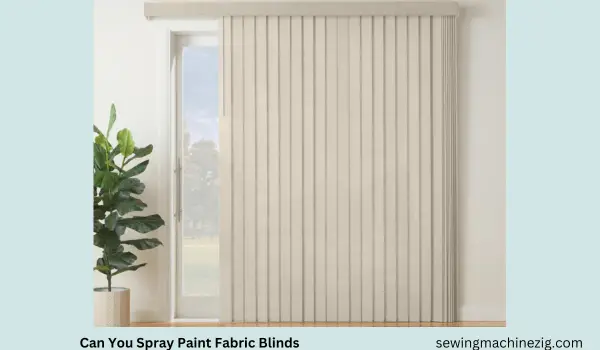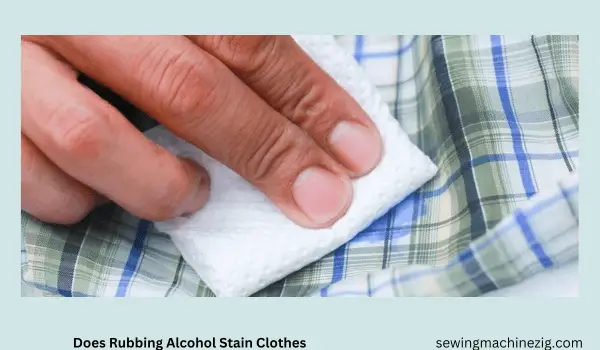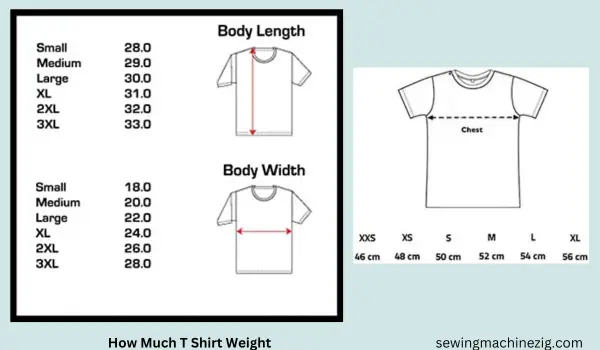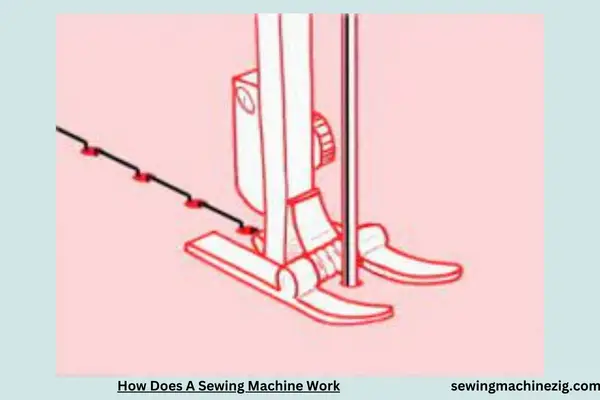
Embarking on the fascinating exploration of textile craftsmanship prompts a curious inquiry: “How Does A Sewing Machine Work?” Delving into the intricate mechanics reveals a mesmerizing ballet of gears, needles, and precision. Unravel the complexity of this mechanical maestro, where each stitch is a choreographed masterpiece.
From the rhythmic dance of the needle to the orchestration of tension discs, understanding the inner workings becomes paramount. Join us in this enlightening journey, decoding the enigmatic synergy between man and machine, where creativity and engineering seamlessly converge in the art of sewing. “How Does A Sewing Machine Work“
How Does A Sewing Machine Work Detailed Answer
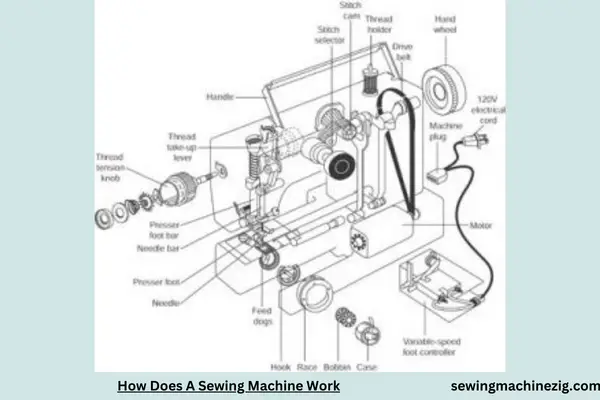
Sewing machines, intricate devices that seem almost magical in their ability to stitch fabrics seamlessly, have been a cornerstone of the textile industry and household crafting for centuries. “How Does A Sewing Machine Work“
In this extensive guide, we will unravel the inner workings of a sewing machine, providing a step-by-step exploration of the mechanisms involved in transforming fabric and thread into beautifully stitched creations.
Step 1: The Power Source and On/Off Mechanism
Before delving into the intricate details, it’s crucial to understand the basics. Most sewing machines are powered by electricity, though manual and foot-operated machines exist. The on/off switch or pedal controls the machine’s power, initiating the movement of various components.
Step 2: Threading the Machine
Threading a sewing machine is the first step in the stitching process. Follow these steps:
a. Upper Thread: – Start by placing a spool of thread on the spool pin. Guide the thread through the thread guide, then down to the tension discs. From there, it passes through additional guides, finally reaching the needle.
b. Bobbin Thread: – Wind the bobbin with thread, ensuring it is properly seated on the bobbin winder spindle. Place the wound bobbin into the bobbin case, threading it through designated guides. The bobbin case is usually located beneath the needle plate.
Step 3: Needle and Needle Bar Movement
The needle is a crucial component responsible for creating stitches. As the machine operates, the needle bar moves up and down, causing the needle to penetrate the fabric. The needle’s eye allows the upper thread to pass through, forming a loop.
Step 4: The Feed Dogs and Fabric Movement
Feed dogs are small, tooth-like mechanisms positioned beneath the needle plate. As the needle rises and descends, the feed dogs move the fabric forward in precise increments. This controlled movement ensures even stitching and prevents fabric bunching.
Step 5: The Tension System
The tension system is a critical part of the sewing machine, controlling the tightness of the stitches. The upper thread passes through tension discs, applying tension to the thread. Adjusting the tension ensures balanced stitches, preventing loose or tight seams.
Common Issues and Solutions:
- Thread Tension Problems:
- Issue: Uneven stitches or thread breaking.
- Solution: Check the upper and lower thread tension. Ensure the threads are correctly threaded through the tension discs and bobbin case.
- Skipped Stitches:
- Issue: Stitches occasionally skip or form uneven patterns.
- Solution: Examine the needle for dullness or damage. Replace the needle regularly to prevent skipping.
- Bobbin Issues:
- Issue: The bobbin thread is uneven or tangled.
- Solution: Re-thread the bobbin, ensuring it’s wound evenly. Clean the bobbin case for smooth thread flow.
- Feed Dog Problems:
- Issue: Fabric isn’t advancing or is unevenly fed.
- Solution: Inspect the feed dogs for lint or debris. Clean the area and ensure the feed dogs are moving freely.
Step 6: Stitch Formation
As the needle pierces the fabric, it forms a loop with the bobbin thread below. A shuttle mechanism, present in many machines, moves the bobbin and creates a lockstitch. This interlocking of threads forms the basis of various stitches, contributing to the durability and aesthetic appeal of the final result.
Step 7: Stitch Length and Width Adjustments
Modern sewing machines offer the flexibility to adjust stitch length and width. These settings allow you to tailor your stitches to match the requirements of different fabrics and sewing techniques. Experimenting with these adjustments helps achieve the desired stitch appearance.
Step 8: Reverse Stitching
Many sewing machines feature a reverse stitching mechanism. By engaging the reverse lever or button, the machine temporarily reverses the direction of stitching, creating a secure backstitch at the beginning and end of a seam.
Additional Mechanisms in Advanced Sewing Machines:
- Automatic Needle Threader:
- Some machines include an automatic needle threader, a mechanism that simplifies threading by guiding the thread through the needle eye automatically.
- Speed Control:
- Advanced machines often have speed control settings, allowing users to regulate sewing speed based on their comfort and the intricacy of the project.
- Decorative Stitches:
- Modern sewing machines offer an array of decorative stitches beyond the basic straight and zigzag. Understanding the stitch selector allows you to explore creative possibilities.
- Computerized Controls:
- Computerized sewing machines feature electronic controls for precise stitch selection, customization, and memory functions for storing preferred settings.
Troubleshooting Electronic Sewing Machines:
- Error Messages:
- Issue: Electronic machines may display error messages.
- Solution: Consult the machine’s manual to interpret error codes. Address issues such as incorrect threading or bobbin problems.
- Software Glitches:
- Issue: Computerized machines may experience software glitches.
- Solution: Turn off and restart the machine. If the issue persists, consult the manufacturer’s customer support or seek professional servicing.
- Needle Position Sensors:
- Issue: Incorrect needle positioning.
- Solution: Calibrate the needle position according to the machine’s instructions. Clean the sensor area to ensure accurate detection.
- Bobbin Sensor Problems:
- Issue: The machine doesn’t recognize the bobbin.
- Solution: Check the bobbin sensor for dirt or damage. Ensure the bobbin is correctly inserted and wound.
Understanding the intricate workings of a sewing machine is empowering, allowing you to maximize its capabilities and troubleshoot issues effectively. Whether you’re a novice or an experienced sewist, exploring the mechanics of your sewing machine enhances your overall sewing experience and opens the door to endless creative possibilities. Happy stitching! “How Does A Sewing Machine Work“
Embroidery Machine How Does It Work
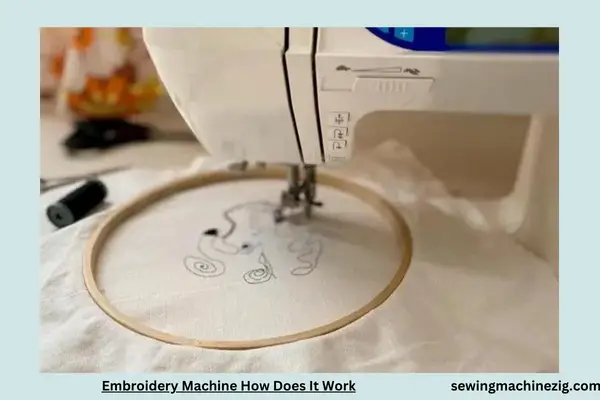
Embroidery machines stand as marvels of modern crafting technology, seamlessly transforming intricate designs into beautifully stitched patterns on fabrics.
In this comprehensive guide, “How Does A Sewing Machine Work” We will embark on a step-by-step journey, exploring the intricate mechanisms that bring life to embroidery and unraveling the mysteries of how an embroidery machine truly works.
Step 1: The Intricacies of the Embroidery Machine Setup
Before delving into the details of embroidery machine operation, it’s imperative to understand the setup process:
- Choose the Right Needle:
- Selecting an appropriate needle is the first step. Consult your machine’s manual to determine the recommended needle type based on your fabric and design.
- Thread the Machine:
- Properly threading the embroidery machine is crucial for smooth operation. Follow the threading path outlined in your machine’s manual, ensuring optimal tension.
- Select the Design:
- Loading your chosen embroidery design is a pivotal step. Modern machines allow for various input methods, such as USB drives or computer connections.
- Hoop the Fabric:
- Achieving proper tension is vital, and this starts with hooping. Securely hoop the fabric, ensuring it remains taut throughout the embroidery process.
Step 2: Dissecting Key Embroidery Machine Components
Understanding the components that make up an embroidery machine is essential in grasping how it functions:
- Needle and Needle Bar:
- The needle, attached to the needle bar, moves up and down, creating perforations for the thread to pass through.
- Thread Tension Mechanism:
- Ensuring the right tightness of the thread is maintained, preventing issues like loose or overly tight stitches.
- Bobbin and Bobbin Case:
- The bobbin, filled with embroidery thread, resides in the bobbin case beneath the fabric, contributing to stitch formation.
- Feed Dogs:
- Feed dogs are instrumental in moving the fabric incrementally, facilitating precise stitching.
- Embroidery Hoop:
- The embroidery hoop secures the fabric, allowing for stability during the embroidery process.
Step 3: Initiating the Embroidery Process
Once the machine is set up, initiating the embroidery process involves several crucial steps:
a. Embroidery Design Placement: – Utilize the machine’s interface to position the embroidery design accurately on the fabric. Some machines feature laser guides for precise alignment.
b. Securing the Fabric: – The machine typically starts with a few securing stitches, anchoring the thread to prevent unraveling during the design.
Step 4: Delving into the Stitching Process
As the machine commences stitching, a symphony of intricate mechanisms comes into play:
a. Needle Movements: – The needle bar moves up and down, creating puncture points based on the selected design.
b. Thread Feed and Tension: – The upper thread passes through the needle, while the bobbin thread emerges from below. Tension mechanisms ensure an even and consistent stitch.
c. Color Changes: – Many machines permit the use of multiple thread colors within a single design. The machine halts, signaling a color change, and prompting the user to switch threads at specified points.
d. Stitch Types: – Embroidery machines offer a variety of stitch types, from satin stitches to intricate patterns, depending on the chosen design.
Common Issues and Solutions:
- Thread Breakage:
- Issue: Frequent thread breakage during embroidery.
- Solution: Inspect the thread path for any snags or obstructions. Ensure the thread spool is correctly placed and of high quality. Adjust tension if necessary.
- Misalignment of Design:
- Issue: The embroidered design does not align correctly on the fabric.
- Solution: Confirm proper hooping and fabric placement. Utilize alignment tools or the machine’s interface for adjustments.
- Thread Nesting or Bird’s Nesting:
- Issue: Excessive tangling of thread on the underside of the fabric.
- Solution: Check the bobbin for proper winding and placement. Ensure correct threading of the bobbin case. Adjust tension if needed.
- Skipping Stitches:
- Issue: Occasional skipping of stitches in the design.
- Solution: Inspect the needle for dullness or damage. Verify the needle is securely inserted and aligned. Adjust tension if necessary.
Step 5: Completing the Embroidery Process
As the machine concludes the design, it typically finishes with securing stitches to lock the threads in place. Some machines offer automatic thread cutting, ensuring a clean and professional finish.
Advanced Features in Modern Embroidery Machines:
- Automatic Thread Trim:
- Many modern machines automatically trim excess thread between color changes or at the end of a design.
- Embroidery Editing Software:
- Some machines are equipped with built-in or companion software for editing and customizing embroidery designs.
- Embroidery Speed Control:
- Adjustable speed settings allow precise control, particularly useful for intricate designs or delicate fabrics.
- Embroidery Hoop Sensors:
- Hoop sensors prevent errors by ensuring that the selected design fits within the embroidery hoop.
Troubleshooting Electronic Embroidery Machines:
- Design Not Loading:
- Issue: The machine doesn’t recognize or load the embroidery design.
- Solution: Ensure the design file is compatible. Check for software updates and consult the machine’s manual.
- Thread Sensor Errors:
- Issue: The machine displays errors related to thread sensing.
- Solution: Inspect the threading path and sensors. Confirm the correct loading and seating of the thread in the tension discs.
- Bobbin Sensor Malfunction:
- Issue: The machine indicates issues with the bobbin.
- Solution: Check the bobbin case for proper placement and threading. Clean the bobbin area and ensure correct bobbin winding.
- Machine Jamming:
- Issue: Frequent jams during embroidery.
- Solution: Clear any obstructions in the bobbin area. Inspect the needle for damage or bending. Ensure the embroidery hoop is securely attached.
Summary:
Understanding the intricate workings of an embroidery machine unlocks a world of creative possibilities. By comprehending each component’s role and addressing common issues, users can unleash the full potential of their embroidery machines, creating personalized and stunning embellishments on various fabrics. Embrace the artistry of embroidery with confidence and skill. Happy embroidering! “How Does A Sewing Machine Work“
How Did The Sewing Machine Work In 1846
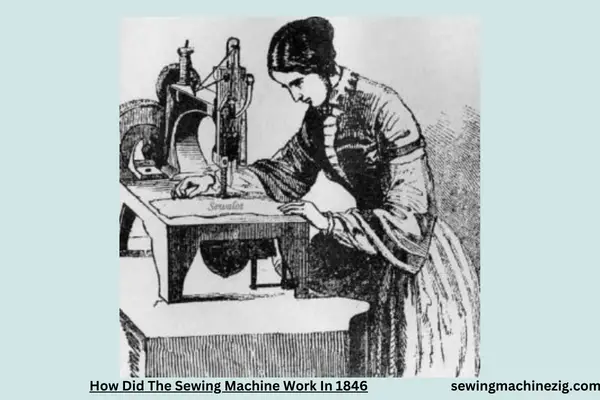
Embarking on a journey through time to the mid-19th century, we delve into the fascinating world of sewing machines in 1846. In a period marked by industrial innovation, the sewing machine played a pivotal role in transforming the landscape of textile production and stitching craftsmanship.
In this comprehensive guide, we will unravel the step-by-step details of how the sewing machine functioned during this pivotal era, shedding light on the mechanisms that fueled the sewing revolution. “How Does A Sewing Machine Work“
Step 1: The Historical Context of 1846
In 1846, the sewing machine was a groundbreaking invention that aimed to revolutionize the laborious and time-consuming task of hand stitching. At this point, various inventors were actively experimenting with designs, seeking a mechanical solution to enhance the efficiency of textile production.
Step 2: The Inventors and Their Designs
Several inventors contributed to the development of the sewing machine during this era, each introducing unique designs and mechanisms:
- Elias Howe:
- Howe’s invention in 1846 is often credited as a significant milestone. His design featured a lockstitch mechanism, wherein a needle with an eye at the pointed end moved through the fabric, creating a loop that was interlocked with a second thread from below.
- Isaac Merritt Singer:
- In the same period, Singer introduced improvements to the sewing machine design, including the incorporation of a foot pedal for hands-free operation. This innovation marked a shift towards more user-friendly and efficient machines.
Step 3: The Lockstitch Mechanism
The lockstitch mechanism, a hallmark of early sewing machines, played a central role in their operation:
a. Needle Movement: – The needle, controlled by a foot pedal or hand-crank, moved through the fabric, creating a puncture point.
b. Thread Formation: – As the needle penetrated the fabric, it formed a loop with the upper thread. Simultaneously, a shuttle or bobbin mechanism positioned underneath the fabric contributed to the lower thread.
c. Interlocking Stitches: – The threads intertwined in the middle of the fabric, creating a secure and uniform stitch. This lockstitch mechanism was a crucial innovation that significantly improved the durability of stitched seams.
Step 4: Manual Operation and Treadle Machines
In 1846, sewing machines were primarily operated manually, often using a foot treadle for power. The treadle, a pedal-like mechanism activated by the user’s foot, provided the driving force to move the needle and shuttle.
- Treadle Operation:
- Users would rhythmically press the treadle to power the machine, controlling the speed and precision of the stitching process.
- Hand-Cranked Machines:
- Some machines featured hand-crank mechanisms, offering an alternative to foot-powered operation. This allowed for greater control and flexibility in sewing.
Common Issues and Solutions:
- Thread Breakage:
- Issue: Frequent thread breakage during sewing.
- Solution: Check the quality of the thread and ensure it is compatible with the machine. Adjust tension settings if needed.
- Needle Breakage:
- Issue: The needle frequently breaks during operation.
- Solution: Use the correct type and size of needles for the fabric. Inspect the needle for any damage or dullness and replace it as necessary.
- Uneven Stitches:
- Issue: Stitches appear uneven or irregular.
- Solution: Check the threading path to ensure proper tension. Adjust the tension settings according to the fabric being used.
- Shuttle or Bobbin Issues:
- Issue: The shuttle or bobbin is not functioning correctly.
- Solution: Clean the shuttle and bobbin area regularly. Ensure the bobbin is correctly wound and placed in the shuttle.
Step 5: Evolution of Sewing Machine Designs in 1846
While the basic principles of sewing machines in 1846 laid the foundation for industrial progress, subsequent years witnessed continuous innovation and refinement:
- Improved Shuttle Mechanisms:
- Engineers enhanced the shuttle design to optimize thread delivery and reduce friction, leading to smoother and more efficient sewing.
- Incorporation of Tension Control:
- Tension control mechanisms were introduced to allow users to adjust thread tension according to different fabrics and sewing requirements.
- Expansion of Stitch Varieties:
- The versatility of sewing machines increased with the introduction of machines capable of producing various stitch types beyond the basic lockstitch.
Step 6: The Impact on Textile Production
By 1846, the sewing machine had started making a significant impact on textile production:
a. Increased Efficiency: – The advent of sewing machines considerably increased the speed and efficiency of stitching, reducing the time and labor required for garment production.
b. Mass Production: – Industrial sewing machines, inspired by the innovations of the mid-19th century, paved the way for mass production in the textile industry. Factories could produce garments at unprecedented rates.
c. Accessibility: – While early sewing machines were primarily used in industrial settings, their accessibility gradually expanded to households, allowing individuals to engage in sewing with greater ease.
Step 7: Historical Challenges and Resolutions
In the early years of the sewing machine, inventors faced several challenges:
a. Patent Disputes: – Elias Howe encountered challenges in securing and defending his patent for the lockstitch mechanism, leading to legal disputes with other inventors.
b. Resistance to Technology: – Some skilled laborers in the garment industry resisted the adoption of sewing machines, fearing job displacement and the potential devaluation of craftsmanship.
Step 8: Legacy and Continued Innovation
The sewing machine’s legacy from 1846 extends into the present, with continued innovation shaping the industry:
- Computerized Sewing Machines:
- Modern sewing machines are equipped with computerized controls, offering a plethora of stitch options, automated features, and digital precision.
- Embroidery and Specialty Machines:
- Sewing machines have evolved to include specialized variants, such as embroidery machines and sergers, catering to diverse crafting needs.
- User-Friendly Interfaces:
- Contemporary machines boast user-friendly interfaces, making sewing accessible to a broader audience. Touchscreen displays and electronic controls simplify operation.
Exploring the workings of sewing machines in 1846 unveils a rich tapestry of ingenuity, challenges, and transformative impact. From the basic lockstitch mechanism to the advent of treadle-operated machines, the mid-19th century laid the groundwork for the sewing revolution.”How Does A Sewing Machine Work“
Understanding the historical context, mechanisms, and challenges of early sewing machines provides a profound appreciation for the evolution that has shaped the modern landscape of crafting and garment production. As we celebrate the legacy of the sewing machine, we honor the trailblazing inventors and their enduring contributions to the art of stitching. Happy sewing!
Conclusion
In conclusion, delving into How Does A Sewing Machine Work unveil the ingenious mechanics that breathe life into your creative visions. Understanding the intricate interplay of the needle, thread, and fabric enables you to harness the full potential of this remarkable device.
As you master the art of manipulating stitches and tensions, a sewing machine transforms into a tool of precision and efficiency. So, embrace the inner workings, and let your sewing machine be the conduit that stitches together your imagination and craftsmanship seamlessly. “How Does A Sewing Machine Work“
FAQS
Q1: How do I thread a Kenmore sewing machine properly?
A1: Threading a Kenmore sewing machine involves several steps. Begin by raising the presser foot, following the thread guides, and ensuring correct needle threading. Refer to the threading diagram in your Kenmore sewing machine’s user manual for precise instructions. “How Does A Sewing Machine Work“
Q2: Can I use any type of thread for threading a Kenmore sewing machine?
A2: Kenmore sewing machines are versatile and can generally accommodate various thread types. However, it’s recommended to use high-quality, all-purpose thread suitable for your specific sewing project. “How Does A Sewing Machine Work“
Q3: Is there a specific needle I should use when threading a Kenmore sewing machine?
A3: Kenmore sewing machines typically use universal needles suitable for most fabrics. Choose the appropriate needle type and size based on the fabric you are working with for optimal stitching. “How Does A Sewing Machine Work“
Q4: What should I do if the thread keeps breaking while threading a Kenmore sewing machine?
A4: If thread breakage occurs, check for proper threading, use the correct needle type, and ensure appropriate tension settings. Regular machine maintenance and consulting the user manual for troubleshooting tips can help address thread breakage issues. “How Does A Sewing Machine Work“
Q5: Can I use different colors of thread in the bobbin and upper thread when threading a Kenmore sewing machine?
A5: Yes, you can use different colors for the bobbin and upper thread. Experimenting with color combinations allows for creative and decorative stitching, enhancing the visual appeal of your sewing projects. “How Does A Sewing Machine Work“
Q6: How do I wind a bobbin when threading a Kenmore sewing machine?
A6: To wind a bobbin on a Kenmore sewing machine, place an empty bobbin on the winding spindle, thread the machine following the guides, and engage the bobbin winding mechanism. Start the machine, and it will automatically wind the bobbin. Refer to the user manual for specific instructions. “How Does A Sewing Machine Work“

